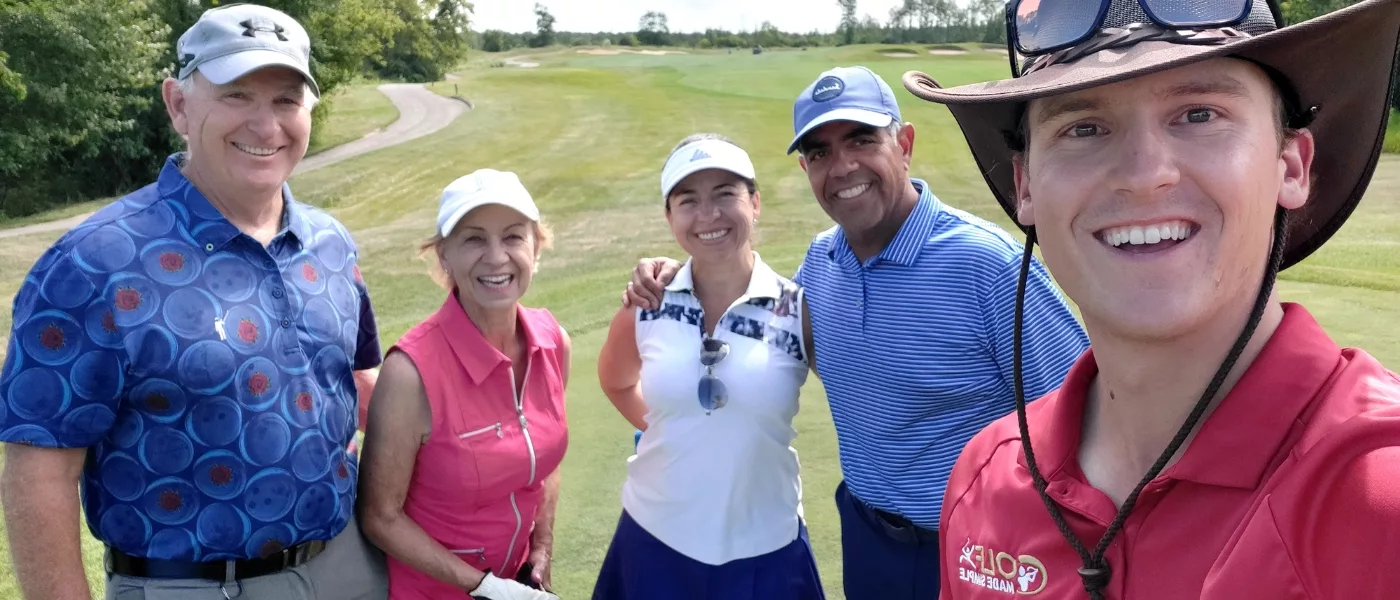Join Us
On The Golf Course Or Social Media

“Golf Made Simple helps everyday Golfers break through frustrating plateaus, hit more consistent shots, and start enjoying the game like never before!”
Golf Made Simple is designed to help you play better, more consistent golf by focusing on what works best for your game. Whether you want to lower your score, hit more fairways, or build a more reliable swing, our system is built to make meaningful improvements that stick.
Turn Practice into Performance: Each day starts with personalized instruction focused on building a swing that works for you. After lunch, you’ll take your skills to the course with your Instructor to apply your improvements under real playing conditions.
Maximize Every Swing: Our sessions aren’t about hitting hundreds of balls. You’ll see improvement using quality over quantity — helping you make every swing count so you develop consistency without fatigue.
Real-World Experience from PGA Pros: With innumerable hours on the range and over 100,000 holes of on-course instruction taught, our Instructors know how to help golfers hit it farther, straighter, and more consistently, all while enjoying the game more.
On-Course Learning Every Day: Instead of solely practicing hitting only to an open range, you’ll also play six holes each afternoon, where you’ll apply what you’ve learned under real conditions — just like the pros do.
Tailored for You: Small class sizes (no more than four golfers) ensure you receive personalized coaching to fit your unique swing and goals. This focused approach eliminates guesswork, so you see results faster.
A Clear PLAN to Keep You Improving: You won’t just leave with a better swing — you’ll leave with a personalized PLAN to make sure the progress you’ve made lasts. Through our Player Page, you’ll have access to video of all your drills, putting techniques, and green-reading strategies so you can continue improving long after the program ends.
More Fairways & Greens: Learn how to make your swing repeatable under pressure.
Greater Distance & Accuracy: Gain power and control with the same swing.
A Reliable Short Game: Develop touch around the greens to lower your score.
With locations in California, Florida, and Spain, our Instructors are ready to help you transform your game. Join over 13,000 golfers who’ve improved through Golf Made Simple—because when you succeed on the course, so do we.
Start hitting better shots, gaining confidence, and having more fun on the course with Golf Made Simple.
At GMS, you’ll immerse yourself in daily instruction that dives into your swing mechanics and mental game. With focused sessions, you’ll have the time and support needed to make meaningful improvements that last. Our program isn’t about temporary gains—it’s designed to make your progress stick so that your swing holds up when it matters most.
Every afternoon, you’ll play six holes with your Instructor right by your side. This isn’t just practice; it’s real-time coaching that covers every aspect of your game — from swing adjustments to club selection and course management. Learning in this environment ensures that the improvements you make on the range translate seamlessly onto the course, helping you make better decisions and execute shots with confidence.
With a maximum of four per class, our Instructors provide individualized feedback based on your unique swing and needs. You’ll receive personal coaching that goes beyond generic advice, giving you actionable steps to improve at your pace. This focused approach ensures you avoid information overload and gain the clarity needed to play your best golf.
Improving your game isn’t just about one session — it’s about knowing how to make adjustments as you continue to play. At GMS, you’ll leave with a clear PLAN for maintaining your progress long-term. Our instruction goes beyond mechanics to teach you how to self-correct and adapt your game to any course or situation.
Each day, you’ll enjoy lunch with your Instructor in a relaxed setting. This is your chance to ask questions, discuss your progress, and gain deeper insights into your game outside of the structured lessons. These conversations add another layer to your learning, helping you connect the dots between theory and practice.
After attending GMS, you’ll gain access to the GMS Club Player Page, filled with videos of the drills you learned to keep your skills sharp. Whether it’s putting, swing mechanics, sand shots, green reading or efficient practice techniques – you’ll have resources at your fingertips to continue practicing.
• More Fairways, More Confidence: Your swing will become more reliable under pressure, so you can play with consistency.
• Distance and Accuracy Combined: Learn to hit the ball farther without sacrificing control.
• A Smarter Approach to Golf: Improve your course management, mental game, and pre-shot routines.
At GMS, everything is designed to help you play better, more enjoyable golf. With our unique blend of range and on-course instruction, a personal PLAN for improvement – you’ll leave hitting the golf ball better than ever, along with ongoing support.

Join a community of Golfers striving for more fun and satisfaction on the golf course. Receive simplified golf advice with actionable steps you can apply to improve your golf swing and mental game. Stay updated with our current locations and instruction offerings. See past issues below to learn how Golf Improvement Weekly can help you!

Enter your email to receive “12 Questions You Should Ask Before Buying Any Golf Instruction” … Find the best golf instruction confidently!